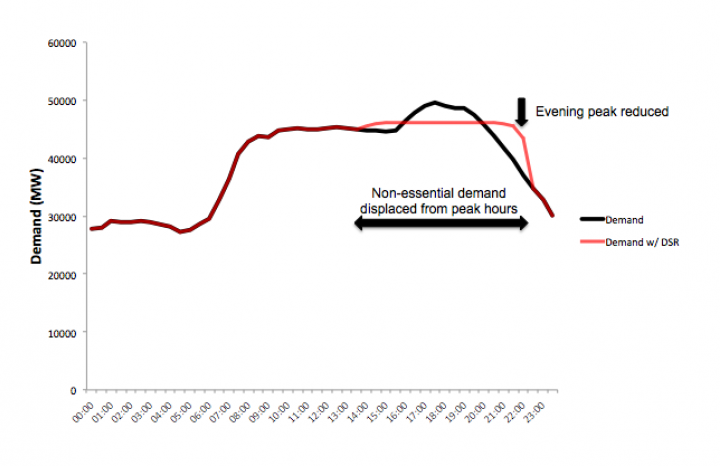Demand Side Response
How can we change how electricity is consumed in a smart grid?

By Dr Simon Cran-McGreehin
@SimonCMcGShare
Last updated:

Typically customers choose to involve electricity use that is not time-critical – for example, a food warehouse could turn off power to a cold store for an hour or two with no impact on temperature, or an office building turn off air conditioning at peak times, turning it on again as the ‘crunch’ eases.
The case for using DSR is enhanced by the move towards more flexible electricity systems where the bulk of generation comes from variable-output renewables such as wind and solar, where supply varies from day to day and week to week.
DSR can also be used to salvage sudden, unplanned fluctuations in demand and supply – for example, when power stations go offline unexpectedly – so increasing the resilience of the UK grid.
In principle, there are three kinds of DSR:
1. Turn-down DSR – Customers reduce demand. For example, when renewable generation is low and demand high, industrial users may receive payment for reducing non-essential power use
2. Turn-up DSR – Customers are incentivised to increase consumption to manage an excess of electricity in the grid, such as increasing industrial refrigeration when supply is abundant
3. DSR by on-site generation – Consumers switch to back-up generators to reduce demand on the grid. Although this is not strictly speaking a demand-side measure, it has the same effect on the grid, because users are generating their own electricity rather than drawing it from the grid. (Sometimes called ‘behind the meter’ generation).
Currently, only turn-down DSR and on-site generation are in use in the UK. The Capacity Market, the government scheme to ensure adequate supplies of electricity in the next few years, does not currently discriminate between the two; both can apply for contracts.
Turn-up DSR is set for a 200 MW “soft launch” in summer 2016.
DSR can be controlled automatically, with a service provider managing the system, or manually with customers selecting when to change use in response to financial incentives. It can work for domestic consumers as well as businesses, although usually this requires ‘aggregation’ of many customers because each household’s energy use is so small.
What are the benefits?
The UK grid comes under the greatest pressure when the margin between supply and demand is at its smallest. By reducing peak demand, DSR contributes to grid stability.
This can reduce the cost of supplying electricity. Studies have shown that peak demand reductions upwards of 4 GW are achievable, more than the capacity of EDF’s proposed £18 billion Hinkley Point C nuclear power plant. A recent Open Energi study showed that shifting 3 GW of peak demand could net the UK £1 billion. Proposals by the National Infrastructure Commission (NIC), accepted by Treasury, show a £8 billion annual benefit following a switch to a smart electricity system, of which DSR is a vital part.
Turn-down DSR has an effect on greenhouse gas emissions. It reduces the need for, and use of, ‘peaking’ generation units usually fired by gas, which produce carbon dioxide. However, on-site generation often involves diesel units, which produce more CO2 than the gas power plants that supply the majority of the UK’s electricity. This is why many experts advocate policies that incentivise turn-down DSR but not on-site generation.
Are there any downsides?
Customers need to sign up for DSR, a barrier which may limit its effectiveness in balancing the UK grid, while issues around automation, data protection and privacy have been shown to dissuade customers. With most interest coming from industrial and commercial users, progress is needed to increase residential sign-ups and maximise the effectiveness of DSR.
To make effective use of DSR, tariff complexity must be increased. This goes against recent policy decisions to simplify household bills and raises potential conflicts with consumer groups.
The view sometimes seen in the media that turn-down DSR forces companies to turn off essential processes such as production lines is, however, a myth. DSR contracts are business deals that companies can negotiate, like any other deal. Business is generally in favour of DSR: it makes some money, switches use to times of lower charges, and reduces the chances of unplanned service interruptions.
How much DSR is in use, and how does the future look?
Following a slow start DSR capacity is increasing rapidly in the UK. This is a result of increased awareness, improving technology and policy changes.
Until changes made in 2019, DSR was unable to compete on even terms with generators in the capacity market. A legal challenge from DSR provider Tempus Energy and changes in the capacity market framework have alleviated this to some degree.
Many onlookers expect DSR to perform strongly in forthcoming capacity market auctions, although there are concerns over the breakdown between ‘true DSR’ and that based on on-site generation.
Overall, the flexible system of the future, incorporating greater use of measures such as wind and solar power, interconnectors and storage as well as DSR, requires a ‘smarter’ and more robust grid than the inflexible system of the past. The pace of network upgrades and smart metering may therefore constrain uptake of DSR.
Studies have shown that more than a third of electricity demand can be reduced under critical conditions, a vast saving that will only improve as technology develops. With such savings on offer, the increased prevalence of DSR as the grid becomes smarter and more flexible seems inevitable.